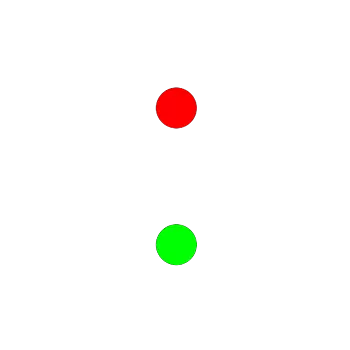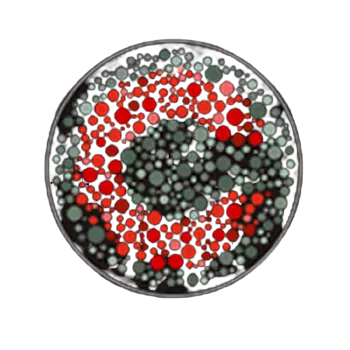Color Blind Test
Take the top-rated online color blindness test at ColorBlindnessTest.org. Detect color vision deficiency and find out if you're color blind in under 2 minutes!
- The test shows you various Ishihara plates, each displaying numbers that you need to identify correctly to pass this test.
- Remove any glasses with colored lenses. This test requires you to use your naked eye for accurate results.
- Increase your screen brightness to a high level. Dim lighting can affect your ability to see colors accurately.
- For better results, take this test on a larger screen, like a tablet or laptop.
WHAT IS COLOR BLINDNESS?
It is a condition in which the ability to distinguish specific range of colors is average. A person suffering from color blindness has trouble seeing red, green, blue, or a combination.
A person's ability to see some combination of colors is rarely lost (monochromacy). Many people believe that only black and white colors are caught in a person suffering from Full(monochromacy) type. It has many different types and levels.
According to one of most popular survey, They will found 8% in men and only 0.5% in women.
HOW DOES THE COLOR BLIND TEST WORK?
The test is designed to evaluate a person's ability to perceive and differentiate between different colors. The most common type of color blindness is red-green color blindness, where a person has difficulty distinguishing between red and green hues. Other types, such as blue-yellow color blindness and total color blindness (achromatopsia).
One of the most famous color blind test is Ishihara Color Test, Designed by Dr Shinobu Ishihara. In this test, we used a series of plates, each containing a circle of coloured dots. Within these dots, numbers or shapes are hidden in a different color, which is hard to identify this color for the color-blind. People with normal color vision can easily identify these numbers or shapes, while those with color vision deficiencies may struggle to see them or see different numbers.
-
Identification of Numbers or Shapes: The plates are presented with different coloured dots in the form of any shape or number.
-
Color Vision Deficiency: A person with color vision deficiencies may have a problem noticing or identifying the hidden numbers or shapes due to the similarity in color between the background and the embedded figure.
-
Diagnosis: Based on the responses and the ability to identify the numbers or shapes, the test can provide information about the type and severity of color vision deficiency.
It's important to note that color blindness tests, including the Ishihara Color Test, are screening tools rather than diagnostic tools. If someone shows signs of color vision deficiency on a test, further evaluation by an eye care professional is recommended for a more comprehensive assessment.
Other types of color blindness tests may involve arranging colors in a specific order, matching colors, or identifying colors under different lighting conditions. These tests help professionals assess the extent and nature of color vision deficiencies in individuals.
TYPES OF COLOR BLINDNESS & THEIR LEVELS
1. Red-Green Type
It is mostly seen in familial causes is damage or reduced red con or green con pigment function. There are four sub type of Red-Green Type
-
Protanomaly - due to the unusual occurrence of red cone pigments. In this type, red, orange, and yellow appear green, and the colors are not bright. This condition is benign and usually does not affect daily life.
-
Protanopia - In this type, the red cone pigments stop working, and the red will appears as black. Some variants of orange, yellow and green all appear as yellow.
Some opticians prefer to use a reverse color blind test to diagnose colour vision deficiency. In this test, the patients are asked to identify the coloured object in the pallet within dynamic colored background.
-
Deuteranomaly - This is the most common type of found in peoples. It has an unusual green cone pigment. Yellow and green appear as red, purple and blue are difficult to identify. This condition is benign and usually does not affect daily life.
-
Deuteranopia - In this, green cone pigments stop working. They see red colors as brownish-yellow and green as dark yellow.
2. Blue-Yellow Type
Blue-yellow type is rarer than red-green. In this, the blue cone pigment (triton) is either absent or has a limited function. There are two types of blue-yellow type.
-
Tritanomaly - Blue cone pigments have less function. The blue color appears as green, and it cannot be easy to differentiate from pink to yellow and red.
-
Tritanopia - People with Tritanopia lack blue cone cells. Blue appears green in this, and the yellow color looks like purple or light brown.
3. Full (Monochromacy) Type
People with full type (monochromacy) do not see any colors, and their clarity of vision can also be affected. There are two types of monochromacy
-
Cone monochromacy - In this, two or three cone cell pigments do not work. People with cone monochromacy have difficulty distinguishing between colors because the brain needs signals from different types of cones to see. This comparison is not possible when only one type of cone works.
-
Rod Monochromacy - It is present from birth. It does not contain any of the available pigments of cone cells. People with rod monochromacy see the world in black, white, and gray. People with rod monochromacy are photophobic and very uncomfortable in bright environments.
WHAT ARE THE USES OF A COLOUR-BLIND TEST?
There are some professions where a colour vision test is required to pass to continue. Some jobs or licencing depends on the nature of the work, especially in those professions where accurate colour vision is required.
Pilot - Aviation Controller: Jobs in the aviation industry often need to pass colour vision tests to serve because it is essential to accurately recognise aviation lights, signals, and other critical information.
Electrician:In the electrician's work, the person must identify color-coded wiring. For safety reasons, the electrician must pass a colour vision test.
Medical Professionals: Some medical professionals may need to pass a colour-blind test, particularly for essential tasks to identify diagnostic tests.
Graphic Design: Professions that involve working with colours, like graphic design, may need to pass colour vision tests to use the correct colours to increase the quality and accuracy of their work in graphic design.
LENSES, GLASSES AND COLOR FILTERS
Opticians supply colored specks lenses or single red-tinted contact lenses to improve vision related to some colors.
Studies show that issues in a cone cause wavelengths to overlap more, consequently leading to poor color vision.
The glasses have tinted lenses that help individuals see colors more accurately.
They use a filter to cut the overlapping wavelengths, allowing the user to give more precise color recognition.
Glasses have many more useful daily life applications, like selecting clothes with perfect patterns of colors. It also helps a person to grow in their color-related profession, such as graphic designing and working profiles that require handling various electrical wiring having lots of colors depend on correct color perception.
References
1. Ishihara, S. (1960). Tests for color blindness.
2. Birch J. Efficiency of the Ishihara test for identifying red-green color deficiency.
Lastly Updated:
07 December 2025
FREQUENTLY ASKED QUESTIONS (FAQ)
Try our free online test for an initial check. It can be done at home by online medium from your pc, laptop, or mobile devices. We have various tests to determine whether you are color blind. Before starting this test, you need to read all instructions, look carefully at a series of Ishihara plates, and then answer some simple questions about what you see in those images. After ending the test, the results will show you whether or not you have color blindness, which is the inability to see color differences in a specific range. Suppose it shows that you failed the test and have symptoms of it. In that case, it is necessary to consult your nearby doctor or optometrist to find out what specific conditions may be causing this condition and discuss Treatment options. Ultimately, taking care of your eyes by identifying any vision problems early can help ensure optimal functioning.
There is no cure for genetic color blindness, but you can use special glasses and contact lenses that helps to see colors.
Driving is a most difficult skill, allowing people to navigate the roads safely and access work, school, and other destinations. However, not everyone has this ability. Some people suffer from color blindness, making it difficult to differentiate some colors and combinations. Many have wondered whether color-blind drivers are safe to drive on the road, but this question depends on their particular type of color blindness. For instance, color blindness can be detected with a simple online test. Regardless of the cause, all color blind drivers can benefit from taking extra care behind the wheel and being especially careful by consulting to doctor and taking Treatment like glasses or lenses while driving.
Our test uses a series of plates, each containing a various circle of coloured dots. Within these dots, numbers are hidden in a different color, which is hard to identify by color blind person as compare to normal person. However, for a accurate diagnosis, you should connect to eye care proffessional.
There are several different types, but the most common type is caused by an altered or absent color of Photopsin pigment in the eyes. It will also be caused by other conditions that affect the eyes, such as cataracts or macular degeneration. Most of all, it is genetic but can also be acquired through illness or injury.
DISCLAIMER
The color blind test was created for informational and educational purposes only. The results provided by this tool are not 100% accurate and should not be considered professional medical advice or treatment. If you think or suspect you have a color blindness-related issue, please consult an eye care professional.






